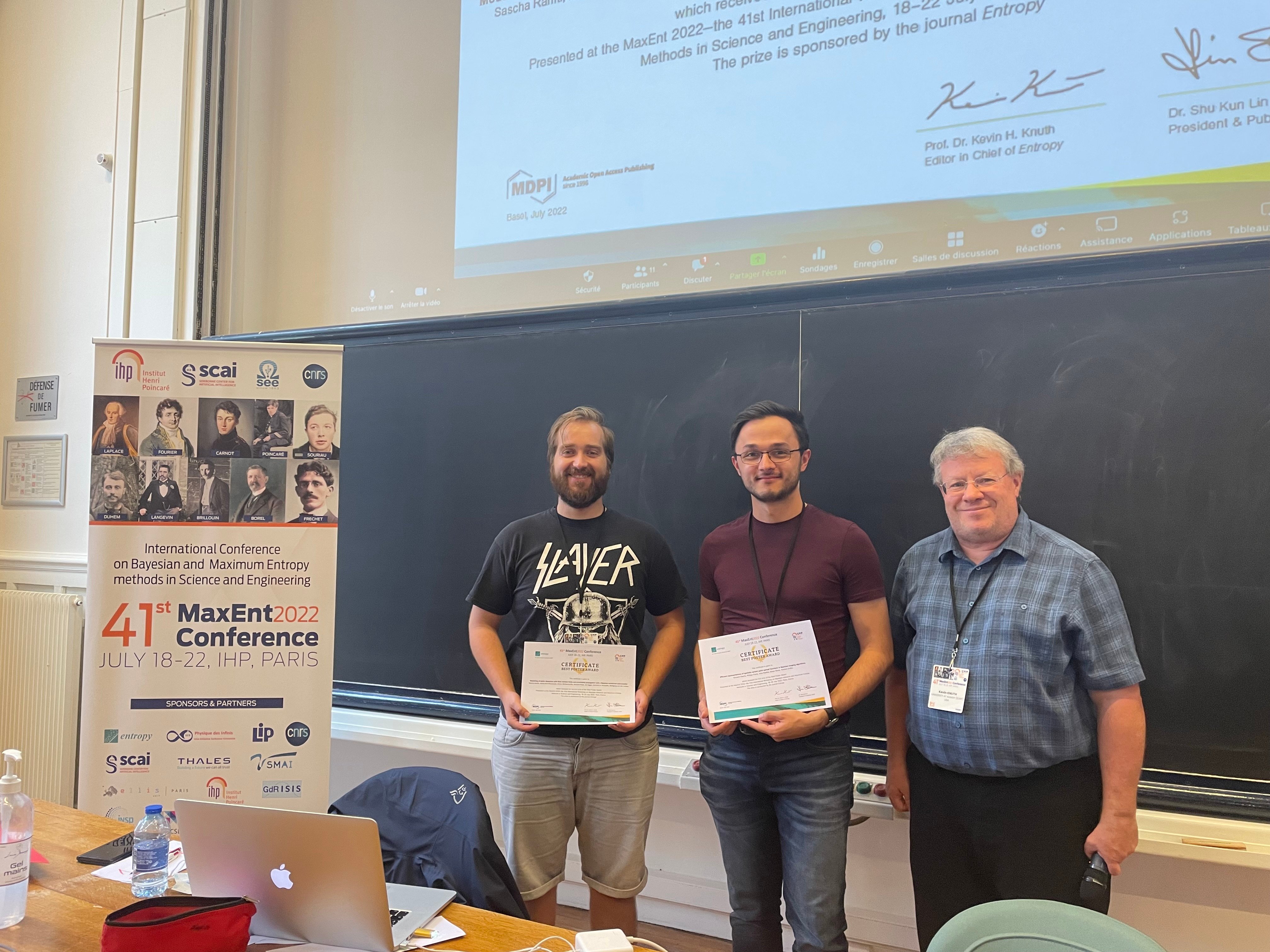Entropy | Best Poster Awards from the 41st International Conference on Bayesian and Maximum Entropy Methods in Science and Engineering (MaxEnt2022)—Winners Announced
We are pleased to announce the winners of the two poster awards sponsored by Entropy (ISSN: 1099-4300) from MaxEnt 2022—the 41st International Conference on Bayesian and Maximum Entropy Methods in Science and Engineering, which took place in Paris (France) from 18 to 22 July 2022.

1st prize
“Efficient representations of spatially variant point spread functions in Bayesian imaging algorithms”
by Vincent Eberle, Philipp Frank, Julia Stadler, Silvan Streit, Torsten Enßlin
Bayesian imaging algorithms are becoming increasingly important in, e.g., astronomy, medicine, and biology. Given that many of these algorithms compute iterative solutions to high-dimensional inverse problems, the efficiency and accuracy of the instrument response representation are of high importance for the imaging process. For this reason, point spread functions, which make up a large fraction of the response functions of telescopes and microscopes, are usually assumed to be spatially invariant in a given field of view and can thus be represented by convolution. For many instruments, this assumption does not hold and degrades the accuracy of the instrument representation. We discuss the application of butterfly transforms, which are linear neural network structures whose size scales with the number of data points subquadratically. Butterfly transforms are efficient by design since they are inspired by the structure of the Cooley–Tukey Fast Fourier transform algorithm. We combine them into butterfly networks in several ways, compare the different architectures with respect to their performance, and identify a representation that is suitable for the efficient representation of a synthetic spatially variant point spread function with up to a 1% error.
2nd prize
“Modelling of aortic dissection with Beta random fields and uncertainty propagation with a Bayesian variational auto-encoder”
by Sascha Ranftl, Malte Rolf-Pissarczyk, GloriaWolkerstorfer, Antonio Pepe, Jan Egger, Gerhard A. Holzapfel, Wolfgang von der Linden
In this work, we create a stochastic constitutive model for arterial tissue mechanics and utilize deep learning surrogates in order to facilitate the ensuing propagation of uncertainties to the Cauchy stress fields resulting from tissue response to a mechanical load. In particular, "aortic dissection" is a dangerous disease that is linked to the stochastic and spatially heterogeneous degradation of the elastin fibers in aortic tissue. Here, this degradation is modeled as a "Beta" random field, i.e., a random field for which every marginal follows a Beta distribution, through a suitable combination of auxiliary Gaussian random fields. Based on this, the Cauchy stress fields in the tissue are computed using a finite element method in response to a mechanical load. Due to the stochasticity of the constitutive model in the input parameters, it is necessary to propagate these uncertainties to the computed mechanical Cauchy stress fields in order to make the simulations interpretable. The prohibitive computational effort of this latter step makes uncertainty propagation with direct sampling infeasible, instead requiring a surrogate model to be learned from a small number of samples from the finite element simulation. The structure of the input data, i.e., "Beta" random field realizations of the tissue's fibers degradation, and the output data, i.e., resulting mechanical Cauchy stress fields, define a problem similar to image-to-image (I2I) regression. This I2I problem structure suggests a convolutional neural network as a surrogate that is well-suited for learning the relationship between the spatial correlations. Here, we chose a Bayesian Variational Auto-Encoder (B-VAE) architecture. After training with Stein Variational Gradient Descent, the B-VAE can subsequently predict approximate Cauchy stress field samples from "Beta" random field samples several orders of magnitude faster, and with non-parametric Variational Inference, it can estimate the PDF of the predicted mechanical Cauchy stress fields. The study is presented within the framework of a rigorous Bayesian analysis. The results quantify the precision of such biomechanical simulations, and biologically relevant implications such as tissue rupture probabilities can be quantified.
Reference: Ranftl, S., Rolf-Pissarczyk, M., Wolkerstorfer, G., Pepe, A., Egger, J., von der Linden, W, & Holzapfel, G.A. (2022). “Stochastic Modeling of Inhomogeneities in the Aortic Wall and Uncertainty Quantification using a Bayesian Encoder-Decoder Surrogate”. ArXiv: abs/2202.10244